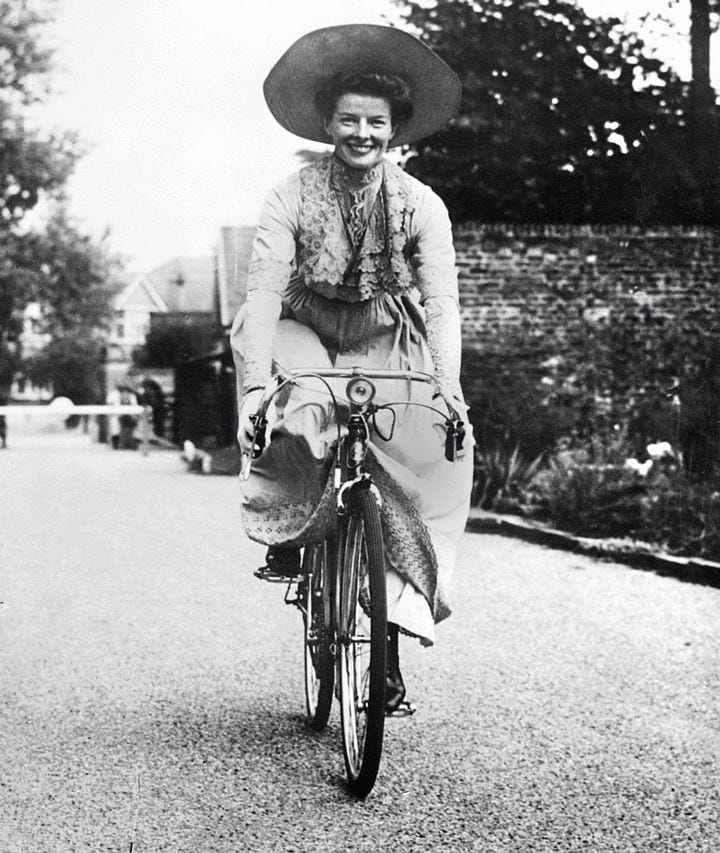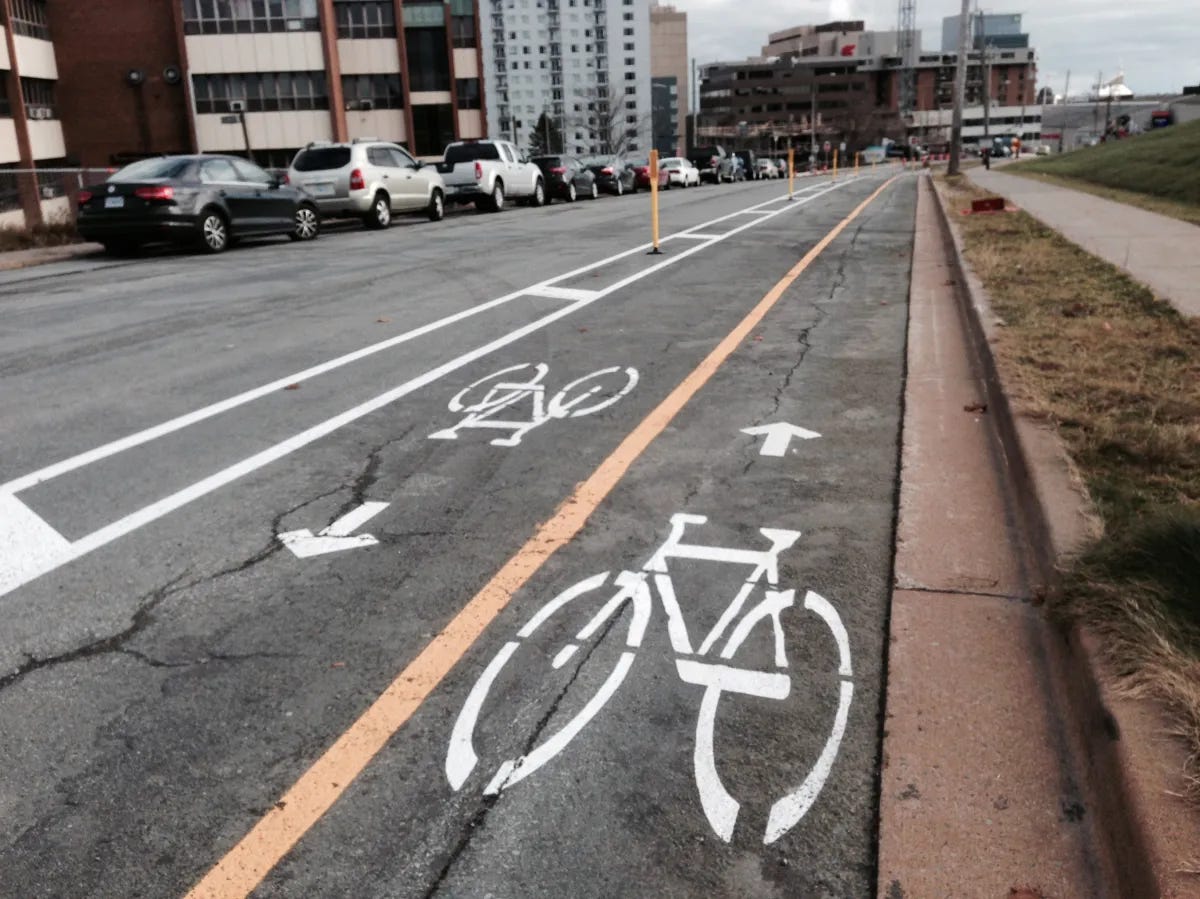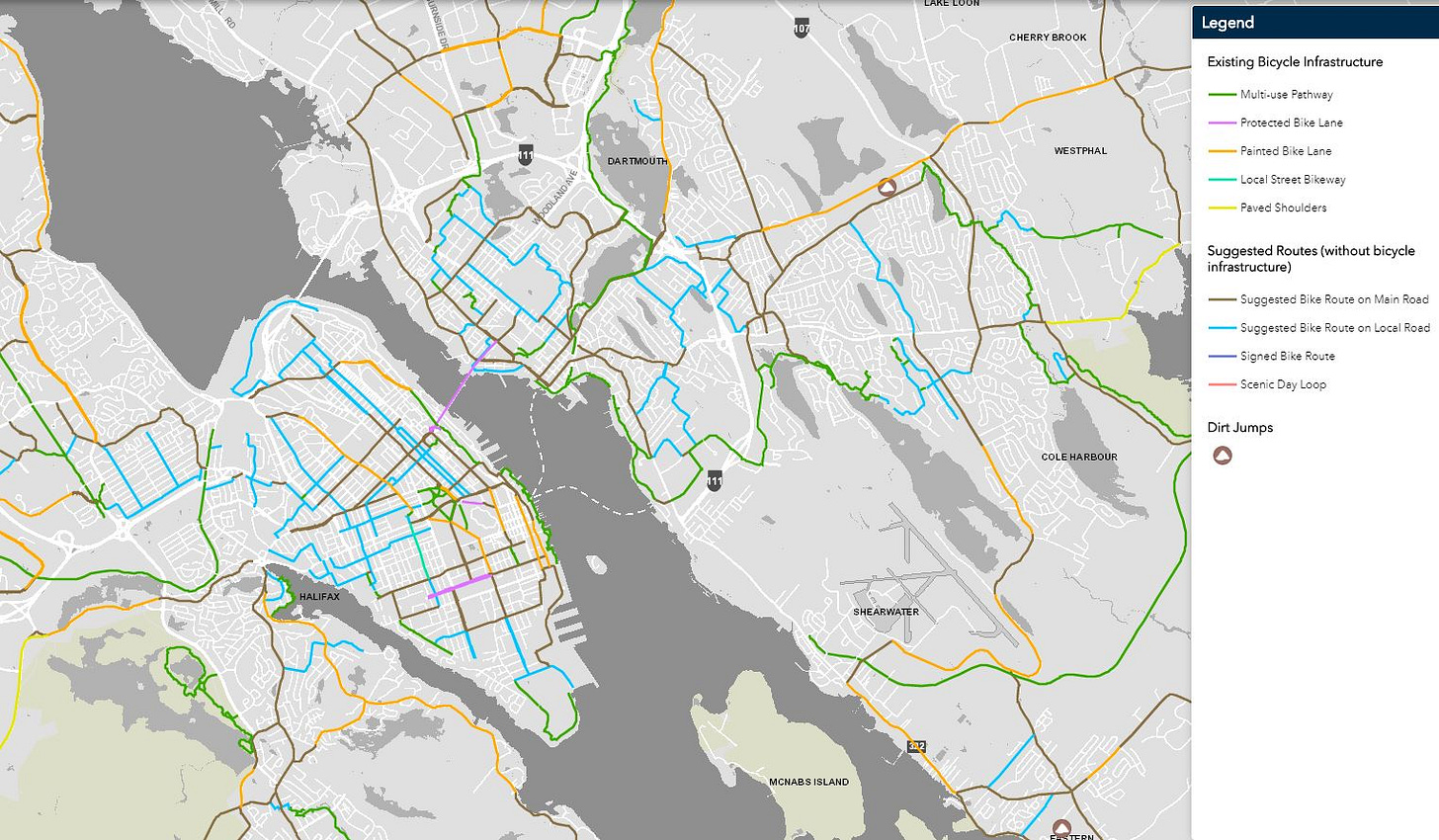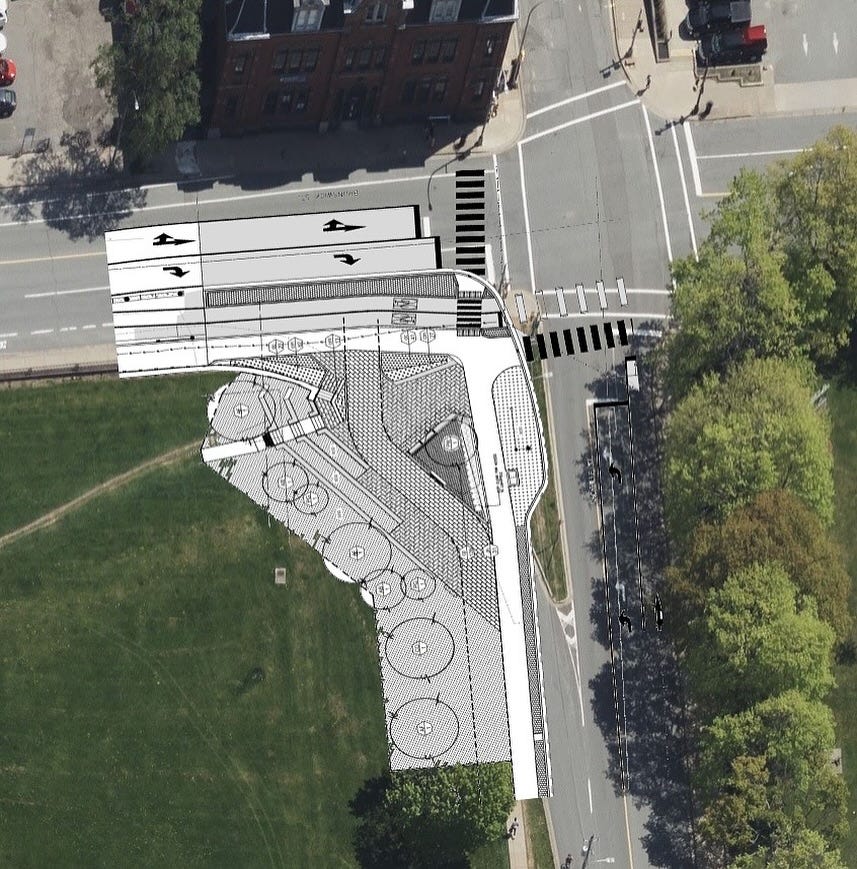How The F^%& Could This Cost A $100 Million?!
The Bureaucratic Halifax Bike Gnomes and the $100 Million Dollar Bicycle Lane Boondoggle
This week, the city quietly released a Friday before the cottage update on the Halifax Bike Lane Network Cost.
From a place of deep bicycle love, this is a story about how Halifax took one of humanity’s most joyful inventions and turned it into a $100 million ideological culture war.
Deeply immoral and fiscally near criminal, it was wrong to use the bicycles that we’ve loved for 100 years against the citizens and the city. What was once a symbol of freedom and fun has been conscripted into a bureaucratic boondoggle—a fantasy where bike lanes would solve traffic, fix the climate, balance the budget, and save the city from itself.
They haven’t. They won’t. And it's time to admit it. This is the Bicycle Lane Boondoggle.
Halifax's Bike Lane Budget: A Quiet Friday Surprise
In a classic Friday news dump, the City of Halifax discreetly announced that its big bike lane network, initially projected at $25 million, is now likely to exceed $100 million. This revelation comes as part of the city's plan to complete the network sometime after 2028, a timeline that has already seen multiple extensions since the project's inception.
The Integrated Mobility Plan, which aimed to create an "All Ages and Abilities" cycling network, has faced delays due to land acquisition issues, construction encroachments, and dependencies on other capital projects. Despite these challenges, city officials keep pedaling, emphasizing the importance of “sustainable transportation options” as if the cost/benefit should be self-evident to all good people.
The escalating costs and prolonged timelines reflect a lack of clear planning and oversight. Co-opting the purity of the intention to promote cycling, the power-mongering plan has been marred by inefficiencies and budget overruns.
This ballooning bike lane budget isn’t just a financial fiasco—it’s emblematic of a deeper pattern where social justice rhetoric becomes the velvet glove over an iron fist of elite control. What starts as a feel-good campaign for “all ages and abilities” quickly mutates into a top-down exercise in power, where a small class of ideologically aligned planners and politicians use the language of equity to bulldoze over the actual needs and voices of everyday citizens. It’s not about bikes—it’s about control of space, movement, and public money. Bureaucracy, once a neutral tool of governance, becomes the vehicle through which a cloistered elite imposes its vision, wraps it in moral superiority, and dares anyone to object without being branded regressive. The result? A city remade not for people, but for the politics of a few.
It’s shameful that bicycles, one of the most perfect machines ever created, have been misused in our city.

Before I start this essay, I just need you to understand — I love bicycles. When I finish this essay this morning, I’m going down stairs to tune up Dorothy’s bike for spring, and I wish her a lifetime of bicycle joy as I have had.
Everyone at some chapter in their life should get to experience the pure pleasure of a nice bicycle.
Here’s my Mom on her push bike.
I grew up surrounded by piles of these old CCM’s and all the fun and adventure they brought.
Working on them is as much fun as riding. It’s a great place for children to learn basic mechanics, design, and tools. Like millions of children, I learned about freedom and which way to turn a wrench on an old CCM steel bicycle. And for that, I am truly grateful.
Eventually, I opened a bike business and got more serious about learning to design and build bicycles. I’m proud to have helped put thousands of beautiful bicycles into the homes and lives of Nova Scotians.


This is the bicycle I designed and built that I am most proud of. It’s based on an early 1920’s CCM style, and I call it a Redbird. As you can see, it has a diamond frame, upright riding position, and tight cockpit, but with a swept-back design that makes the bike very agile and gives almost the feeling of flying.
The secret of this bicycle is that, along with its simple lug construction and sturdy design styling, it has 29-inch wheels and an 11-speed internal hub, making it a match for Halifax and anywhere your spirit might take you on road or off.


Over the years, I collected words and thoughts about bicycles that capture my feelings about the machines that have meant so much to me in life.
It’s passenger is its engine; it is the vehicle of novelists, poets and dreamers; it has the swiftness of motion that is perhaps the most fascinating feature of material life; as other forms of transportation grow more nightmarish it remains pure of heart, but it has a thin edge of danger that keeps you alert and alive - it turns dogs into dogs and makes potholes personal; it is not that expensive but it is the possession most likely to be stolen;
It is completely incompatible with melancholy; it’s a conveyance of precision and balance that puts us in competition with any animal that has ever lived and in spirit puts us in mind of flight; we use it to avoid exertion but the more we use it the more useful it becomes and the more healthy we become; after we use it the memory of the motion lingers in our muscles and often in to our dreams - as is often observed that feeling is never forgotten as long as we live; it does no harm and is of little offence to anyone; it carries kings and kingpins, socialists and sexpots equally well, it provides the very best way to learn the contours of a country and the limits of love;
It’s a flight from sadness; it has a humane almost classical moderation yet it has been to war, emancipated women and ushered in sensible dress; it asks for and in return gives the gift of balance – one of the great accomplishments of early life; it must surely be a part of the future; it is a thing of beauty and a joy forever - ride-able art and while you’re on it the world is breaking someone else’s heart; it is freedom in machine form; it is a bicycle.
Canadian singer Coco Love Alcorn put it all more beautifully in song than anyone.
The Backstory
I had come into some money from a big TV series deal with Nat Geo, and my intention was to build a city bike factory here in Nova Scotia. My thinking was if we could design and build a bike like the Redbird for Halifax hills and weather, it would sell anywhere where the geography of biking was a challenge. To make sure I had the idea right, I opened a storefront on Quinpool Road (Halifax Cycles) and brought in what I thought were the best of the best country and city bikes in the world from Italy, England, Denmark, Holland, and America.
I had a very specific market in mind: People who biked for the love of bicycling. People who just loved the machines, the idea, the feeling, and the beauty of bicycles.




The shop was a joyful place. We sold, maintained, and shared the love of bicycles with many. I was convinced that the idea of a bike that met Halifax’s geographic challenges was possible.
What I couldn’t overcome was the city’s bureaucracy’s vision of bicycles as a desperately dangerous, highly politicized tool for commuting — a means to a budgetary and ideological end.
When the bike lane talk started, I closed the design and build business, and gave the storefront shop to the loyal and much-loved shop mechanic.
Three years and about $340,000 down, I put the idea aside and moved on to a new project. It was a big loss. And kinda sad.
But it’s what happened next that is truly awful.
How The F^%& Could This Cost A $100 Million?!
The city of Halifax somehow took the machine and the culture I loved and turned it into a widely reviled, political, ideological, divisive issue to be solved for the benefit of a mostly mythical non-existent elite — the Halifax bike commuter.
And somehow they’ve spent 10 years and over $100 Million Dollars doing it.
How could that happen?
The Bicycle Lane Boondoggle
This is what they did to the machine I love.
The city of Halifax somehow took bicycles—these beautiful, simple machines that represent joy, freedom, and self-reliance—and turned them into a political weapon, a budgetary sinkhole, and a planning ideology so divorced from reality it feels like performance art.
They spent over ten years and going on to $100 million creating a “bike lane network” designed not for children learning to turn wrenches or families riding to school—but for a near mythical but apparently all-powerful figure I’ve never once met outside the… whatever we call hipster class now: the downtown Halifax year-round bicycle commuter.
You want to know how things go wrong in city planning? Step one: fall in love with an idea. Step two: ignore data, ignore outcomes, ignore the weather and people who live here. Step three: throw money at it until you forget what problem you were trying to solve in the first place.
Step four: PR it to death.
And here we are.
Bike Lanes By The Numbers
HRM data counted a daily average of 342 bike trips across the Macdonald Bridge alone in 2024. Let’s assume that’s a return trip, so that’s 171 people… out of about 500,000 in Halifax, and about a million in Nova Scotia.
Charitably, assume the $100 million over 30 years and that the 171 grows 10X to 1,710 who take a bike trip every day, winter, spring, summer, and fall.
Assumptions:
Total Cost of the bike lane network:
$100,000,000Time Horizon to spread the cost:
30 yearsDaily Bike Riders (10× increase from 2024 data, assuming round trips):
1,710 people per dayTrips per Year:
1,710 riders × 365 days = 624,150 trips/yearTotal Trips over 30 Years:
624,150 trips/year × 30 years = 18,724,500 trips
Cost per Trip:
$100,000,000/18,724,500 trips=$5.34 per trip
Even under cartoonishly optimistic usage assumptions, that’s the real fare being charged for each bike lane crossing—just hidden in taxes and capital budgets instead of collected at a toll booth.
Under a more cynical—but arguably realistic—calculation, assuming just 171 daily bike rides on warm, sunny days (about 120 days a year) over a 10-year lifespan before major upgrades are needed, the cost per trip is approximately $487.33. That’s near $500 per mostly peninsular trip… enjoy the ride!
That’s not infrastructure. That’s performance art with a $100 million ticket price.
Looked at another way, what's the cost per kilometre if $100m buys 53 km of bike lanes?
Next time you are out, take a close look at that bike lane painted on the ground.
At nearly $2 million per kilometre, Halifax’s bike lane network isn’t infrastructure—it’s a heist in broad daylight, politely disguised as progress.
When you’re spending more per kilometre than it costs to build rural highways—without expropriation, bridges, or major engineering—it stops looking like bad management and starts looking like something else. Something that ought to have auditors nervously clearing their throats.
No one’s suggesting envelopes are changing hands in back alleys. But when a city government can burn through $100 million to build 53 kilometres of underused lanes for a few hundred daily users, and no one is held to account, it tells you something more disturbing: you don’t need criminals when you have bureaucracy, ideology, and zero consequences.
It’s not theft. It’s worse. It’s government.
Someday a real rain is gonna come and wash the paint off these streets…
Ask yourself, honestly, how many people you know commute by bike in Halifax? Not in July. Not in theory. But today. In traffic. In snow. In sleet. In the dark. On icy hills. Hauling groceries. Hauling kids.
How many?
And yet, we’ve reoriented downtown planning, gutted curbside parking, choked key arteries, and repainted streets in a confusing modernist abstraction—all to accommodate this elite mythic class of cyclists who barely exist outside consultant reports and council PowerPoints.
Look around. Does it feel like success?
We didn’t fix traffic. We made it worse. We didn’t reduce emissions. We offloaded the costs to working families stuck idling in longer commutes. We didn’t encourage exercise or freedom. We built corridors of rage and resentment—where once people got along, now they honk, swerve, curse, and feel unsafe.
But wait — it’s much worse than that.
The Real Cost of Bike Lanes
The biggest mistake in economics is taking too narrow a view over too short a period of time with too small a group of people.
That’s exactly the error baked into Halifax’s bike lane boondoggle. City Hall will tell you it’s a $100 million investment in “active transportation.” But they’re only counting what’s easy to see. What they don’t count—what they won’t count—are the real costs, which stretch far beyond bollards, paint, and paving.
Here’s a fuller reckoning.
1. Lost Productivity and Congestion
By narrowing key arteries and creating deliberate obstacles to vehicular traffic, the city has lengthened commute times and delivery routes—costs measured not just in minutes, but in stress, fuel, wages, missed appointments, and lost income.
Multiply that over the years and across an entire working population, and you’ve got hundreds of millions in opportunity costs that never make it into the bike lane budget.
2. Economic Displacement of Small Business
Reduced street parking and chaotic street reconfigurations have pushed customers away from downtown shops and services. Businesses that rely on visibility, foot traffic, or convenient access are being strangled—not by competition, but by policy.
This is gentrification by white paint, and it’s small local business that pays the price.
3. The War on the Working Vehicle
Halifax's plan, whether stated or not, is a campaign to make driving harder. And that means tradespeople, parents, delivery drivers, health workers, musicians, and caregivers are the collateral damage in a war they never signed up for.
These aren’t idle Sunday drivers. They’re the people who keep the city running—and they’re being squeezed out by a city that thinks their lived reality is a problem to be solved.
4. Bureaucratic Expansion
Bike lanes are just the visible output of a growing class of consultants, planners, public engagement managers, active transportation officers, equity assessors, and climate auditors. Each lane comes with not just construction cost, but an entire ideological apparatus baked into permanent payroll.
That’s a long-term tax burden in the form of a growing, self-justifying bureaucracy.
5. Cultural Division and Distrust
By treating dissent as obstructionism, and using moral language to silence legitimate debate, the city has poisoned its own civic well. These lanes have become symbols of class division, urban-suburban hostility, and bureaucratic arrogance. That social cost is real, and it’s rising.
When you step back and take the long view—across time, across class, across the full economy—it becomes clear:
This isn’t about bike lanes. It’s about priorities. It’s about power. And it’s about the quiet, creeping cost of pretending ideology is a substitute for economics.
The bill hasn’t arrived yet. But make no mistake: Nova Scotians are already paying.
Halifax Has A Bike Gnome Problem
We didn’t solve transportation. We politicized it.
Worse still, we used the bicycle—this humble, human-powered invention—as a human shield for an ideological war about urban density, car bans, and an anti-suburban fantasy masquerading as climate action.
We’ve committed a kind of civic moral fraud. We said this was about bikes. It was never about bikes.
It was always about bureaucracy, power, and control… like a bunch of Underpants Gnomes.
And like the South Park Underpants Gnomes, Halifax bureaucracy of bike gnomes has its own plan:
Step 1: Build Bike Lanes
Step 2: ???
Step 3: Problem Solved!
But there is no Step 2. There never was. Because the problem wasn’t bikes. It wasn’t cars either. The problem was—and still is—urban planning that refuses to learn, adapt, or admit when it's wrong.
Bike Lanes and the Gnome Doctrine: A Vision Problem
How many well-meaning city staff clock in every day, attend planning meetings, file reports, and approve line items—but have no real idea why they’re doing it? They might say it’s about sustainability, or mobility, or active transit—but push them on it, and you’ll find a hollow echo, not a compelling vision.
They’ve become like the South Park Underpants Gnomes of municipal governance. Step 1: Build bike lanes. Step 2: ??? Step 3: City transformed!
But the crucial middle step—the actual mechanism by which all these bike lanes are supposed to fix Halifax’s transportation crisis—has never been articulated. Not with numbers. Not with outcomes. Not with anything you could call a strategy. Just vibes and vision boards.
So now we have a city full of “underpants”—miles of painted lines, bollards, curbs, and confusion—but no meaningful shift in commuter behaviour, no relief in traffic congestion, no drop in car ownership, and no sign of a coherent path to the promised “mode shift” future.
Just infrastructure for a cultural identity, not a transportation system.
What is Halifax’s true city-building vision? Do our councillors understand it? Do staff? Do the people footing the bill—the citizens—feel emotionally aligned with it?
Because if they don’t, then this isn’t vision—it’s a vague, unchallenged ideology. One that stalls Halifax’s ability to solve real problems and locks us into a planning inflection point we can’t grow beyond.
This isn’t a matter of being against bikes. It’s a matter of being for clarity. It’s that simple… and apparently, that difficult.
Hinterland Who’s Who: The Halifax Bike Commuter
So who is this Halifax bike commuter we’ve spent $100 million designing the city around?
I’ll tell you who I see in those lanes: city planners. Transportation consultants. Urbanist bloggers with handlebar mustaches and Masters degrees in "livable density." If there’s anyone pedalling these painted corridors of ambition, it’s the people who planned them.
You could throw a helmet and hit five of them at a “Knowledge Cafe” public consultation meeting.
These aren’t average people. They’re true believers, often salaried to be. And their presence in the lanes doesn’t prove demand—it proves the city has built a lifestyle feedback loop where the only people benefiting from the infrastructure are the people who approved it and are paid to talk it up.
It’s less a transportation network than a taxpayer-funded cosplay of what a sustainable city is supposed to look like.
Step 1: Hire a planner.
Step 2: Build what they ride.
Step 3: “See? Someone’s using it!”
It’s a gnome logic loop: the people building the network are the network.
Time to Call It
It’s time to stop. Right now.
Call it. Take the loss. Spend a tenth of what’s left putting the streets back the way they worked, invest in what actually moves people, and let bicycles be what they were always meant to be: fun, and freeing.
Not a $100-million wedge dividing a city against itself.
You can love bicycles and still hate what Halifax has done with them.
Because this isn’t about bikes anymore. It’s about a planning class that mistakes symbolism for strategy. It’s about leaders who refuse to admit a mistake because they spent a long time and a lot of money making it. It’s about a city that built a monument to an ill-imagined future while neglecting the messy, car-filled, family-hauling, weather-pounded present.
There’s no shame in trying something bold. The shame is in doubling down when it clearly didn’t work.
We don’t need another kilometre of painted failure. We need humility. We need honesty. And we need to stop letting ideology steer the handlebars of public spending.
Take the loss, Halifax. End the boondoggle.
And let bikes be bikes again.
The Answer? Here’s one possibility. It’s Simpler Than You Think.
We don’t need $100 million in ideological paint jobs. We don’t need a maze of pylons, curbs, and consultant plans. What we need is something that costs nothing and restores everything: personal responsibility.
Let bikes roll prudently on the sidewalks—as they already do in most of the city without incident (with zero enforcement of existing laws). Let pedestrians and cyclists negotiate shared space like the adults and children we are. These sidewalks, by the way, are barely distinguishable from the so-called “multi-use trails” we spent millions to brand and pave. The difference isn’t material—it’s philosophical.
The solution isn’t more government. It’s more trust in people.
Give citizens credit. Most of us are perfectly capable of managing our own affairs without a bureaucratic babysitter dictating how many metres of painted lane we deserve. The safest, sanest, and most sustainable system is one where people—not planners—are responsible for how they move through the world.
Let bikes be bikes. Give people the chance to be good to each other. And let’s call this boondoggle what it is: a failure of trust disguised as a plan.
Then we can get down to the real problem of a misguided urban and up Sim City gone mad being imposed on what is effectively a 3km x 7km small island when 80% of the province is uninhabited and there are over 200 small communities starved for investment and capital.
POSTSCRIPT: ZOOM IN
This is the current plan for the corner of Brunswick and Sackville. The complexity and confusion are only eclipsed by the breathtaking cost.
You know, I’m just paranoid enough to wonder if city staff wanted the bike lanes to fail—or at least didn’t care whether they did. There’s a part of me that suspects the whole thing was set in motion with full knowledge that it would collapse under its own absurdity.
It reminds me of the board game Mousetrap—that chaotic tangle of pulleys, marbles, and swinging boots based on the cartoons of Rube Goldberg. A contraption built to do something simple in the most over-complicated, failure-prone way imaginable. One part triggers the next, each more ridiculous than the last, until the whole mess falls apart and misses its mark completely. Sound familiar?
Or maybe it's more of a municipal Catch-22. After being hounded for years by the bicycle lobby, the quiet cynics in the back rooms of city hall finally saw their chance for revenge: Give them everything they want. Build it all—lavishly, blindly, unreasonably. And in doing so, turn the city against them forever.
It’s not planning. It’s punishment.
It’s not policy. It’s wrath—biblical in scale and slow-burning in effect.
And in the end, nobody enjoys the ride.














AMEN!! We've been fighting the university Avenue portion for so long the mayor is not listening the Counsellor is not listening. They're ripping down so many trees, they're messing up the traffic flow, they have not provided a single shred of data to justify this. I travel beside the bike lanes and I never see anyone in them. Where is the business case? This is an absolute travesty! Stop it now take the loss leave the rest of the city alone. Repair what you've broken. How did city counsellors get this kind of power? The power not to listen to the majority of their constituents!
The profound stupidity is shocking. $100M on bike paths for a city that is bitterly cold for half the year, and prone to ice and snow for ⅓? Now Halifax has the fifth worst traffic in North America. Leftists destroy every city they touch, from Portland to Vancouver to now Halifax.